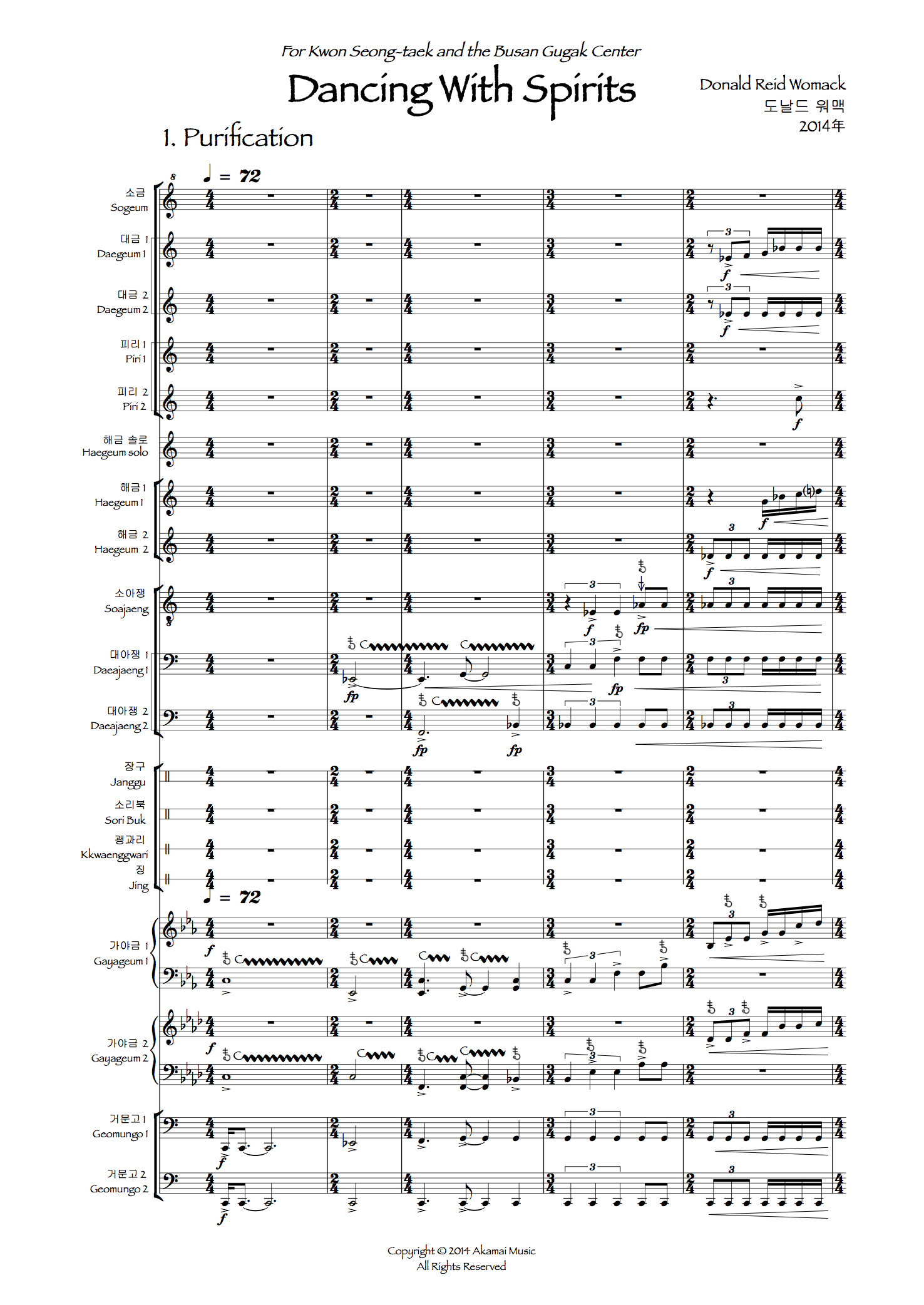Dancing With Spirits 혼무
(gugak orchestra version)
Price range: $35.00 through $550.00
haegeum concerto
해금과 국악관현악를 위한 협주곡
23:00
2014
Dancing With Spirits is based on the East Coast Byolshin Gut of South Korea, a lengthy ritual in which a mudang, or shaman, seeks the blessing of ancestral spirits for the well being of a fishing village. Taking the form of a concerto in eight short movements played without pause, the piece features solo haegeum in the role of the mudang, interacting with the orchestra in much the same way that the mudang would interact with both the supporting musicians and the audience guests at the gut. A dynamic performer as well as medium to the spirit world, the mudang is the central focus of attention, controlling the pace of the ritual proceedings through singing, dancing and storytelling.
The word “spirits” in the English title has three meanings. Most importantly, it refers to the ancestral spirits who may bless the fish harvest, and to whom the villagers feel a deep connection. Second, it suggests the “spirited” character of the mudang and supporting musicians, who sustain an immense energy that builds over the course of many hours. Finally, it also refers to “spirits” in the sense of alcohol, as an essential part of the gut is entertainment — of both human and spirit guests.
Rather than reproducing the music of actual Byolshin Gut, Dancing With Spirits takes elements such as melodic gestures and jangdan (traditional rhythmic patterns) to depict characters and scenes of this thriving traditional Korean art form. While each village has its own unique gut, they share many common elements, some of which are represented by the various movements of Dancing With Spirits.
1. Purification 정화
The first movement represents the cleansing of the ritual space, with which Byolshin Gut normally begins. The music repeatedly builds towering, gritty chords, gradually getting faster and louder until a climax is reached on a “pure” open 5th, at which point the mudang dramatically emerges in full costume.
2. Shaman Stories무당연희 巫話
In the second movement, a cadenza for the solo haegeum, the mudang engages the guests with stories, in an almost conversational way. After each phrase of the story, the guests respond enthusiastically with shouts of approval.
3. Shaman Dances 무무 巫舞
The third movement continues directly from the second, as the mudang summons the spirits through dance. Drawing on various jangdan of Byolshin Gut, the movement builds in energy toward a climax, at which point it abruptly ends.
4. Procession 혼맞이
In the fourth movement the mudang leads the villagers to a shrine, where they invite more spirits to join. A recurring jangdan forms the basis of the music, as the procession slowly wends its way to the nearby mountains.
5. Drums and Gongs 화랭이
The fifth movement depicts the supporting musicians, who typically play the percussion instruments janggu, buk, kkaengkwari and jing. Beginning quietly with perhaps an unexpected scoring, the piece transforms into the intensely energetic sound that typifies Byolshin Gut.
6. Shaman Songs 무가巫歌
The sixth movement uses both jangdan and song fragments from actual Byolshin Gut to depict the song element of the ritual. The mudang gradually becomes more animated as she works her way higher and higher.
7. Dancing With Spirits 혼무
Starting quietly, the seventh movement slowly builds to a frenzied climax, where the mudang finally reaches a state of ecstasy, communing with the spirits. A trance-like pattern gradually evolves higher and faster until it reaches its apex, after which it comes crashing down, as if the mudang returns from a higher plane to her earthy place, where, exhausted, she gathers herself in a restrained solo cadenza.
8. Departing Spirits 사신
The brief final movement is a farewell, as the spirits return to their own world, gently floating off into the heavens.
Commissioned by the Busan Gugak Center, Dancing With Spirits is dedicated to its artistic director, Kwon Seong-taek.

